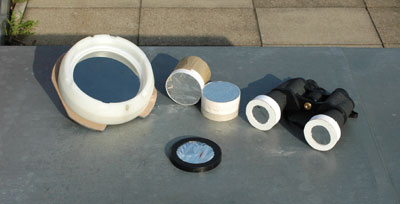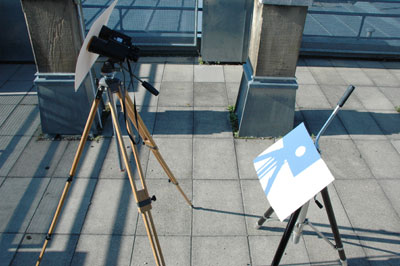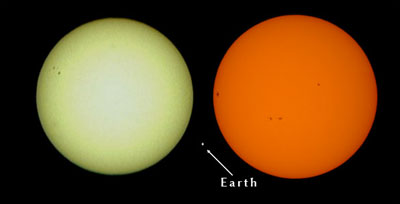!!!CAUTION – NEVER LOOK AT THE SUN WITHOUT PROPER FILTERS!!!!
The Sun is the most dangerous object you can observe. The eye can be damaged when you look for some time into the Sun with the naked eye. However, with the naked eye your reflexes are good enough so that you turn away fast enough to prevent damage if you accidentally look into the Sun. The situation is different, however, if you look through binoculars or a telescope. Here the light is collected and amplified, so there may be immediate and permanent damage to your eyes. A saying among astronomers is that you can look only twice at the Sun through a telescope without a filter – once with the right eye and once with the left eye. With binoculars, it may come down to one last look. One reason is the high-energy ultraviolet radiation from the Sun, which can quickly cause a sunburn on the retina – but in contrast to skin cells, the burned sensory cells cannot regenerate, but remain dead. In addition, the infrared radiation heats the eye. Since cells and proteins can be damaged from about 104°F (40°C) and begin to die, the danger is obvious. At still higher temperatures, the eye itself is almost cooked, and proteins begin to decompose – like the clear egg white of an egg in a frying pan turns to an opaque egg white.

Therefore, either front lens solar filters are required for safe solar viewing or you project the solar image onto a piece of paper.
There are usually no special Sun filters (neutral or gray filters) offered for binoculars, but the company Baader Planetarium (http://www.protecsolar.com) offers a filter film which is on both sides covered with metal. This foil is suitable for the production of telescope filters. It lets only 0.0001 % of the incoming light pass through. You can easily build secure filters for each front objective lens of your binocular. Since the filters are made of a very thin film, you should examine it before each use for small cracks or holes, and store it safely when not using it. To ensure that they can‘t fall off, you can secure the filter with additional tape.
The film is similar to the film which is also used for solar or eclipse glasses. However, do not in any case simply hold eclipse glasses in front of the binoculars – the filter must cover the lens completely and must not slide around. Since binoculars act like a magnifying glass, you must under no account put on eclipse glasses yourself and then look through the binoculars – a hole can be burned into the protective film very quickly.
There are also special solar binoculars, but they are rare. These are usually small, compact devices with built-in lens filters. They also usually have wide eyecups, so there is no glare from stray light. These binoculars can be used for solar observation only.
Through the filter, it is not easy to find the Sun at all – only when it is in the field of view, you can even see anything at all.
Any type of solar eyepiece filters, as they are known, should be immediately disposed of. These filters are mounted in the vicinity of the focal point and receive the full solar energy. Those darkened glasses will become hot and can break, just like holes can be burned into eclipse glasses. In any case, the time may not be sufficient to look away when this happens, and permanent eye damage may be therefore inevitable. Also welders’ glasses, exposed strips of film negatives or CDs are not suitable as a solar filter, because they only block the visible part of the solar radiation. Only lens filters made of special materials prevent dangerous amounts of energy from being collected.

The safest option is the Sun projection. Since this, however, will heat the binoculars so that the glue or plastic inside of it can soften or evaporate, you should not project the Sun too long and, if possible, use a pair of binoculars, which is not too valuable to you. The problem occurs mainly when no tracking is used – then the concentrated sunlight wanders rapidly from the eyepiece to the housing interior. For the projection, attach the binoculars on a tripod, align it by the shadow it casts (always remember – never look directly through the device into the Sun!) and hold a white sheet of paper behind it. You‘ll have to find the correct distance by trial and error.
Especially if you show the Sun to a group, you have to be careful that no one accidentally looks through the binoculars while it is pointed at the Sun (this is equally true for small children and pets as well as for know-it-all fellows who think that solar observing is harmless) – never let it stand unattended.
 The sun in white light – on the left almost without spots on May 4th, 2004 and on the right on June 17th, 2004. The color difference is caused by different filters – on the left with Astro Solar film and on the right a glass solar filter. The dot shows the size of the Earth at the same scale.
The sun in white light – on the left almost without spots on May 4th, 2004 and on the right on June 17th, 2004. The color difference is caused by different filters – on the left with Astro Solar film and on the right a glass solar filter. The dot shows the size of the Earth at the same scale.